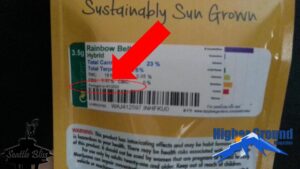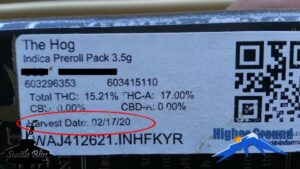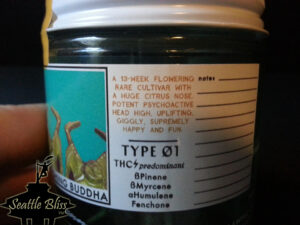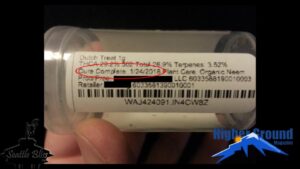Higher Ground used to calculate freshness based solely upon the harvest date as related to the review date, but as freshness is relative, things change. Some Growers have discovered preservation methods and packaging that extends freshness, or at least the appearance thereof.
Everyone seems to understand that the freshest buds are indeed the best. However, many of us understand a little bit of cure time is good. I can recall several occasions in which I was consuming cannabis aged a full year, that I couldn’t tell was aged over three months. The best curing will mellow out the THC-monoterpene bite and any lingering chlorophyll responsible for the so-called harshness of a potent crop. All of this takes place in the slow months of curing exercised (as of late) by only the best cannabis growers (Ellins C., et al., 2015). After the cure, it’s All About Storage.


Outdoor crops are typically harvested in the fall and winter months. If you are enjoying outdoor cannabis during the fall or winter months, chances are your buds have aged almost one year. This is fine – just so you know. Check the label. You’ll find the harvest date as required by most state regulating bodies.
Containers Matter
Freshness is very important When selecting your cannabis. Jars add to the cost of cannabis, but there is no substitution. Don’t blame the grower for poorly preserved cannabis when it was your decision to buy a zip bag. Go for the Cannabis in jars and you’ll be happy every time. Freshness is the payoff.

If your cannabis came in a zip bag, having aged a full year it should be very dry. Please don’t be upset with a grower for having packaged the amount you purchased in a zip bag. Most producers offer glass jars for 3.5 g sizes and larger. This grower packages 3.5 grams and up in glass jars, while others pack jars all the way down to the one gram size. Small jars may be plastic, which won’t be recycled because they’re small, but the sentiment is there.
Minor Losses
Table 1: THC degradation to CBN over 1 year in storage shown as a loss of THC potency.
| Initial THC Potency | Loss (1st year) | THC Potency at 1 year |
|---|---|---|
| 25% | 4% | 21% |
| 20% | 3.2% | 16.8% |
| 15% | 2.5% | 12.5% |
According to Ross and Elsohly (1997), THC oxidizes at a rate of 16.6% in the first year. Knowing that concentrations such as this don’t follow a linear pattern but a curved one instead, it is reasonable to assume that much of that THC, perhaps 10%, degrades into CBN during the first 4 to 6 months. It isn’t THAT big of a loss, but a sample testing at 25% THC on January 1st will degrade to 22% by July, and to less than 21% by year’s end. A 20% sample would degrade in a year to 16.8%, and a 15% sample of “dad weed” would drop in a year to 12.5%.
The most popular brands have a high throughput rate at the retailer. Ask any retailer for the freshest stock and they’ll show you their best selling brands. Stick with them and you can be pretty confident you’ll obtain fresh cannabis.

Read the label. Harvest date may not be required, but the best brands won’t fail to put it on the label, so see for yourself. If you want THC potency, buy uncured and super-fresh. If you’re buying for the smoothness of the cure, pay a little more and buy that brand with the impeccable four month cure.
—
References
Ellins C., et al. (2015), U.S. Patent Application US20170094920A1 (abandoned) Integrated incubation, cultivation and curing system and controls for optimizing and enhancing plant growth, development and performance of plant-based medical therapies; https://patents.google.com/patent/US20170094920A1/en
Ross, S. A., & ElSohly, M. A. (1997). CBN and∆ 9-THC concentration ratio as an indicator of the age of stored marijuana samples. Bulletin on Narcotics, 49(50), 139-139. Online at https://www.unodc.org/unodc/en/data-and-analysis/bulletin/bulletin_1997-01-01_1_page008.html


